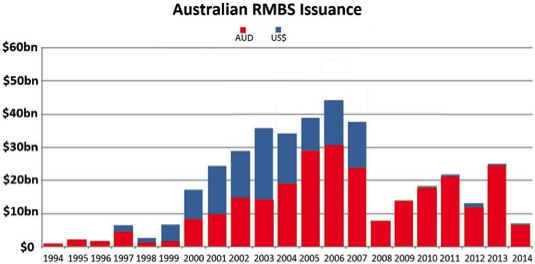The Australian interest rate securities market is seeing increasing issuance of Residential Mortgage-Backed Securities (RMBS) from lenders. Because of the attractive ways many of these issues are priced, they are proving to be increasingly popular with investors.
RMBS are securities that pool individual residential mortgages into one instrument in a process called securitisation. The RBMS is issued by a mortgage provider and pays a yield to investors. The mortgage provider acts as the originator/sponsor of the RMBS.
The payments received from homeowners are pooled by the originator and these cash receipts are used to pay investors holding the RMBS. In practice, different residential mortgages with varying credit ratings are pooled together and sold in tranches to investors looking to diversify their portfolios or hedge against certain types of risks.
From a credit risk perspective, a small number of mortgages might default but the overall yield should compensate the holder of an RMBS for this possibility. The broader the geographic spread of mortgages, the safer an RMBS is likely to be. Conversely the narrower the geographic spread the riskier the RMBS is likely to be.
Once the mortgages are securitised in the RMBS, they are taken off the balance sheet of the originator. This is one of the core differences between covered bonds (also known as mortgage covered bonds) and RMBS. Like a bond, an RMBS has a principal investment and a yield: in the case of RMBS the principal investment represents a payment for the right to receive cash flow from an investment agreement. The yield is the calculation of imputed interest that stems from the receipt of the cash flows. Because RMBS typically involve large numbers of individual mortgages, their return is generally considered stable and predictable.
Recent RMBS to come to market recently have included Firstmac 1A-2014. So popular was the issued that the transaction was increased from an original $500m equivalent to $750m. Much like regular debt issues from Australian corporates these types of issues are generally rated by one or more of the major credit rating agencies. In the recent Firstmac issue, for instance, the main tranche was rated AAA by Standard & Poor’s.
Other recent issues include IDOL 2014-1 from ING Bank Australia, Series 2014-1 WSTTrust from Westpac and Resimac Premier Series 2014-1.
The chart below shows the growth of Australian RMBS issuance denominated in AUD and US$ since 1994.

As the chart shows, the widespread adoption of securitisation in the early 1990s allowed smaller lenders to compete with the big banks in Australia and saw the birth of new lower cost players like Aussie Home Loans.
As with every other debt market around the world, the advent of the GFC saw the Australian RMBS market shrink. Between October 2008 and April 2013, the Australian Office of Financial Management was directed by the treasurer to invest in Australian RMBS to support competition in mortgage lending from a diverse range of lenders. In April 2013, the treasurer issued a direction to the AOFM to cease making new investments in RMBS. Between November 2008 and August 2012 the AOFM had purchased $15.5bn of RMBS.
Now that the RMBS market is back on a growth trajectory, there is no further need for AOFM support and indeed the AOFM has been selling down its holdings.
A sample of recent pricing of Australian RMBS issues:
| Issuer | Tranche | Size (m) | Margin |
| Firstmac 1A-2014 | Class A-1 | $340.00 | BBSW + 93bps |
| Class A-2A | US$270.0 | Libor + 35bps | |
| Class A-3 | $37.50 | BBSW + 110bps | |
| Class AB | $45.75 | BBSW + 170bps | |
| Class B-1 | $22.50 | BBSW + 280bps | |
| Class B-2 | $3.75 | BBSW + 340bps | |
| Class B-3 | $3.00 | Undsc | |
| IDOL 2014-1 | Class A | $460m | BBSW + 83bps |
| Class AB | $30m | BBSW + 145bps | |
| Class B | $10m | ND | |
| Series 2014-1 WSTTrust | Class A | $2.3bn | BBSW + 78bps |
| Class B | $85m | Undsc | |
| Class C | $115m | Undsc | |
| Resimac Premier Series 2014-1 | Class A1 | US$200m | Libor + 70bps |
| Class A2 | $470m | BBSW + 105bps | |
| Class AB | $33.75m | BBSW + 160bps | |
| Class B1 | $25.875m | BBSW + 275bps | |
| Class B2 | $4.125m | Undsc |
 |
Paul McNamara is an editor and journalist with over 20 years’ experience. His career includes spells with the Financial Times, Euromoney, BRW Media, Asia-Inc and Banker Middle East. At present he is editor of YieldReport. YieldReport is a digital newsletter that carries comprehensive pricing and commentary on Australian interest rate securities in a monthly and weekly report. Each issue covers bank bills, cash accounts, term deposits, government bonds, semi-government and corporate bonds, hybrids, ETFs, managed funds and more. Click here for a free trial subscription. |
|








